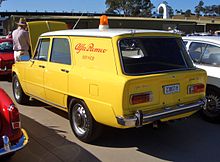| Alfa Romeo Giulia (Type 105) | |
|---|---|
 Alfa Romeo Giulia Super | |
| Overview | |
| Manufacturer | Alfa Romeo |
| Production | 1962–1978 |
| Assembly | Portello Plant, Milan, Italy (1962–1965) Arese Plant, Arese (MI), Italy (1965–1978) Setúbal, Portugal (Movauto) Willowvale (Salisbury), Zimbabwe (Willowvale Motor Industries)[1] |
| Designer | Giuseppe Scarnati |
| Body and chassis | |
| Class | Large family car (D) |
| Body style | 4-door notchback saloon |
| Layout | Front-engine, rear-wheel-drive |
| Related | |
| Powertrain | |
| Engine | |
| Transmission | 4-speed manual (Giulia 1300) 5-speed manual |
| Dimensions | |
| Wheelbase | 2,510 mm (98.8 in)[2] |
| Length | 4,140 mm (163.0 in)[3] |
| Width | 1,560 mm (61.4 in)[3] |
| Height | 1,430 mm (56.3 in)[3] |
| Kerb weight | 978–1,130 kg (2,156–2,491 lb)[4] |
| Chronology | |
| Predecessor | Alfa Romeo Giulietta (750/101) |
| Successor | Alfa Romeo Giulietta (116) |

Alfa Romeo Giulia (Italian pronunciation: [ˈdʒuːlja]) is the name of three not directly related models by the Italian car manufacturer Alfa Romeo. The first is a line of sporty four-door compact executive cars (Type 105) produced from 1962 to 1978, the second is an updated, mainly up-engined Spider, Sprint and Sprint Speciale Giuliettas, and the third Giulia is a compact executive car (type 952) unveiled in 2015.
Alfa Romeo was one of the first mainstream manufacturers to put a powerful engine in a light-weight 1 tonne (2,205 lb) four-door car for mass production.[5] The Type 105 Giulia was equipped with a light alloy twin overhead camshaft four-cylinder engine similar to that of the earlier Giulietta (750/101) range, available in 1.3-litre (1,290 cc) and 1.6-litre (1,570 cc) versions. Various configurations of carburetors and tuning produced power outputs from about 80 to about 110 bhp (55 to 75 kW), coupled in most cases to 5-speed manual transmission.
Giulia sedans were noted for lively handling and impressive acceleration among small European four-door sedans of their era, especially considering modest engine sizes offered. The popular Super version with the twin carburettor 1.6 litre engine had a top speed of 170 km/h (106 mph) and accelerated from 0 to 100 km/h (62 mph) in about 12 seconds, better than many sports cars of the late 1960s and early 1970s.[5] When leaving the factory all variations of the Giulia originally fitted either Pirelli Cinturato 165HR14 or 155HR15 tyres (CA67).
The styling of the boxy four-door notchback saloon was somewhat wanting. The engine bay, cabin and boot were all square shaped, buffered somewhat by details on the grill, roofline, bonnet and boot. Use of a wind tunnel during development led to a very aerodynamic shape that produced a drag coefficient of Cd=0.34,[6][7] particularly low for a saloon of the era.[8]
The Giulia Spider was succeeded by the Alfa Romeo Spider (105/115) in 1966.
- ^ Google-books: Alfa Romeo Berlinas - John Tipler - Google-kirjat, accessdate: 21. October 2018
- ^ "1964 Alfa Romeo Giulia Super". histomobile.com. Archived from the original on 2008-07-24. Retrieved 2008-09-05.
- ^ a b c "1964 Alfa Romeo Giulia 1300". carfolio.com. Archived from the original on 27 September 2007. Retrieved 2007-09-05.
- ^ "Alfa Romeo Giulia". carsfromitaly.net. Archived from the original on 27 September 2007. Retrieved 2007-09-05.
- ^ a b Classic Driver Market: . This punchy power plant ensured the cars performance was better than many sports car of the era. Alf, accessdate: 31. July 2017
- ^ "L'Alfa Romeo Giulia festeggia 50 anni". Il Sole 24 ore. 27 June 2012. Retrieved 9 July 2012.
- ^ "La nuova Alfa Romeo "Giulia", ultima di una serie". Panorama. 25 June 2012. Retrieved 10 July 2012.
- ^ Hemmings Motor News: https://www.hemmings.com/magazine/hsx/2017/04/Aerodynamic-Efficiency---1969-Alfa-Romeo-Giulia-1300-TI/3750710.html, accessdate: 30. July 2017